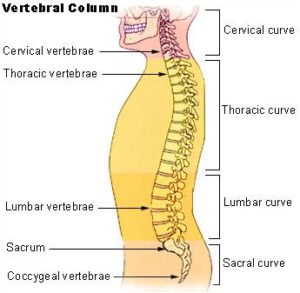The spine is comprised of 33 vertebrae, divided into 5 regions; cervical (neck), thoracic (mid-back), lumbar (lower back), sacral and coccygeal (tailbone). Each region has its own natural curve, and proper posture can be understood as the spine being aligned according to these curves.

Last time I wrote about Forward Head Posture, i.e. Tech Neck, a medieval back problem we’ve brought to epidemic levels in the technology era. Today, I’m going to move down the spine into the thoracic (mid-back) region to talk about another old posture problem increasingly common today; hunchback, or thoracic kyphosis.
As with last time, I’m going to google “hunchback.” This results in fewer hits than tech neck, “only” about 8 million (rather than 89 million):

Still, 8 million hits for a condition that used to be associated scholars and the elderly is plenty. So, let’s talk about it.
Hunch back is an too much curvature in the thoracic spine. Your shoulders slump in, your chest sinks in and your jaw drops. This is very common in office workers, who live hunched over a desk, but can happen to anyone who sits, or leans over, a lot.
Hunch back compresses your internal organs, leading to digestive problems and reduced lung capacity. The extra curvature of the spine will leave it aching, and the compression of your guts will give you abdominal pain. Long periods of sitting, in addition to hunchback, are associated with increased risk of cancers, including colon and lung (‘member where I said “Hunch back compresses your internal organs, leading to digestive problems and reduced lung capacity?”).
Conclusion? Sit less. For we desk jockeys, get up more often and take a walk around. Get a combination/stand up desk. Make sure when you’re sitting, you’re in a good ergonomic chair. And most of all, learn good posture; sit up right and StandUpRight. You will look better, you will feel better, and there’s a pretty good chance you will even live longer.
